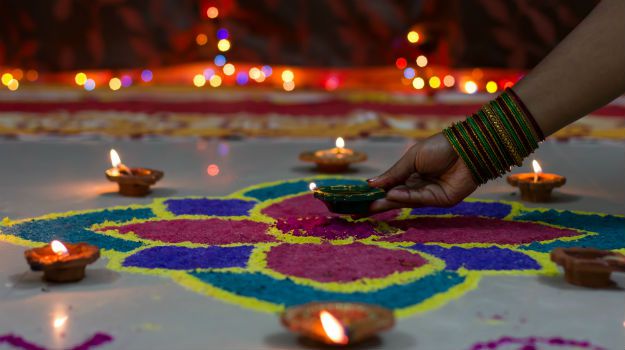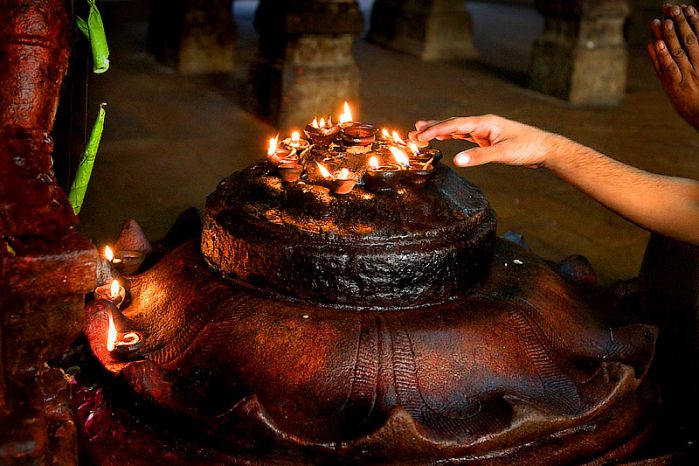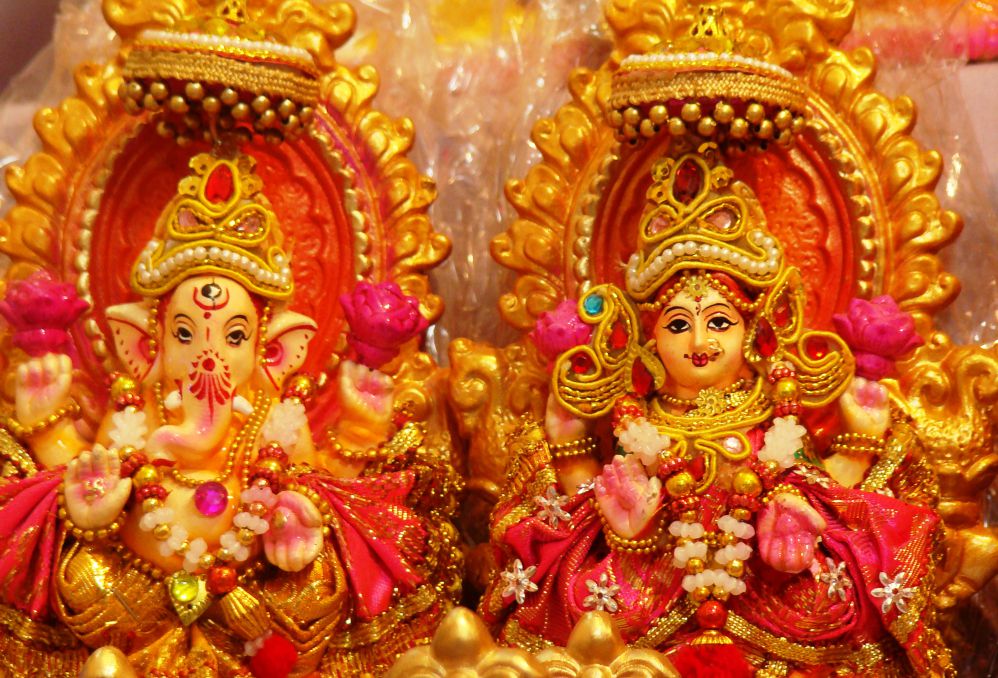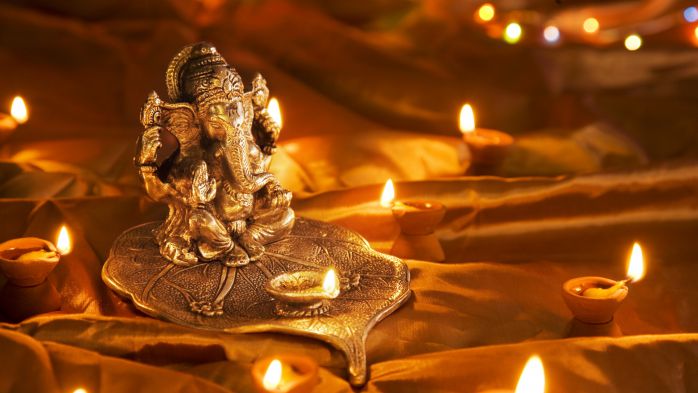No products in the cart.
Diwali or Deepavali is a festival where people from all age groups participate. They give expression to their happiness by lighting earthen ‘diyas’ (lamps), decorating the houses, bursting firecrackers and inviting near and dear ones to their households for partaking in a sumptuous feast. The lighting of lamps is a way of paying obeisance to god for attainment of health, wealth, knowledge, peace, valor and fame.
On Diwali night, little clay lamps are lit in Hindu homes, but now a days colored electric lamps are also used. If asked about the significance of lighting a lamp during this particular festival, there is a logical answer to this question. It is through the light that the beauty of this world is revealed or experienced. Most civilizations of the world recognize the importance of light as a gift of God. It has always been a symbol of everything positive in our world of experience.
To Hindus, darkness represents ignorance, and light is a metaphor for knowledge. Therefore, the celebration of Diwali symbolizes the destruction, through knowledge, of all negative forces- wickedness, violence, lust, anger, envy, greed, bigotry, fear, injustice, oppression and suffering, etc.
The Origin of Diwali
Historically, the origin of Diwali can be traced back to ancient India, when it was probably an important harvest festival. The festival is mentioned in Sanskrit texts such as the Padma Purana, the Skanda Purana both completed in second half of 1st millennium AD but believed to have been expanded from a core text from an earlier era. However, there are various legends pointing to the origin of Diwali or ‘Deepawali.’
1.Goddess Lakshmis Birthday: The Goddess of wealth, Lakshmi incarnated on the new moon day (amaavasyaa) of the Kartik month during the churning of the ocean (samudra-manthan), hence the association of Diwali with Lakshmi. Lord Ganesha, the elephant-headed God, the symbol of auspiciousness and wisdom, is also worshiped with Goddess Lakshmi in most Hindu homes Diwali.
2. Vishnu Rescued Lakshmi: On this very day (Diwali day), Lord Vishnu in his fifth incarnation as Vaman-avtaara rescued Lakshmi from the prison of King Bali and this is another reason of worshipping Ma Larkshmi on Diwali.
3. Krishna Killed Narakaasur: On the day preceding Diwali, Lord Krishna killed the demon king Narakaasur and rescued 16,000 women from his captivity. The celebration of this freedom went on for two days including the Diwali day as a victory festival.
4. The Return of the Pandavas: According to the great epic Mahabharata, it was Kartik Amavashya when the Pandavas appeared from their 12 years of banishment as a result of their defeat in the hands of the Kauravas at the game of dice (gambling). The subjects who loved the Pandavas celebrated the day by lighting the earthen lamps.
5. The Victory of Rama: According to the epic Ramayana, it was the new moon day of Kartik when Lord Ram, Ma Sita and Lakshman returned to Ayodhya after vanquishing Ravana and conquering Lanka. The citizens of Ayodhya decorated the entire city with the earthen lamps and illuminated it like never before.
6. Coronation of Vikramaditya: One of the greatest Hindu King Vikramaditya was coroneted on the Diwali day, hence Diwali became a historical event as well.
7. Special Day for the Sikhs: The third Sikh Guru Amar Das institutionalized Diwali as a Red-Letter Day when all Sikhs would gather to receive the Gurus blessings. In 1577, the foundation stone of the Golden Temple at Amritsar was laid on Diwali. In 1619, the sixth Sikh Guru Hargobind, who was held by the Mughal Emperor Jahengir, was released from the Gwalior fort along with 52 kings.
8. In Bengal the festival is dedicated to the worship of Mother Kali, the dark goddess of strength.
9. In Jainism, Deepawali has an added significance to the great event of Lord Mahavira attaining the eternal bliss of nirvana. All the simple rituals of Diwali have a significance and a story to tell.
Panchang Details for Diwali
The Significance of Diwali
The Significance of Lights & Firecrackers
The illumination of homes with lights and the skies with firecrackers is an expression of obeisance to the heaven for the attainment of health, wealth, knowledge, peace and prosperity. According to one belief, the sound of fire-crackers are an indication of the joy of the people living on earth, making the Gods aware of their plentiful state. Still another possible reason has a more scientific basis : the fumes produced by the crackers kill a lot of insects and mosquitoes, found in plenty after the rains.
The Tradition of Gambling
The tradition of gambling on Diwali also has a legend behind it. It is believed that on this day, Goddess Parvati played dice with her husband Lord Shiva, and she de lacreed that whosoever gambled on Diwali night would prosper throughout the ensuing year. Diwali is associated with wealth and prosperity in many ways, and the festival of ‘Dhanteras’ (‘dhan’ = wealth; ‘teras’ = 13th) is celebrated two days before the festival of lights.
From Darkness Unto Light
In each legend, myth and story of Diwalii lies the significance of the victory of good over evil; and it is with each Deepawali and the lights that illuminate our homes and hearts, that this simple truth finds new reason and hope. From darkness unto light — the light that empowers us to commit ourselves to good deeds, that which brings us closer to divinity. During Diwali, lights illuminate every corner of India and the scent of incense sticks hangs in the air, mingled with the sounds of fire-crackers, joy, togetherness and hope. Diwali is celebrated around the globe.
Traditionally believed to be a a Hindu festival of wealth and prosperity, it is amazing to see how Diwali has become an occasion for all Indians irrespective of their status and cast. In different parts of the country this sparkling festival is celebrated in different ways.
Diwali Celebrations
Diwali Celebrations in North India
According to the great Hindu epic ‘Ramayana’, Diwali is believed to be the time when Lord Rama defeated and killed the evil King Ravana and after passing a period of of fourteen years in exile returned to his capital Ayodhya (in the Faizabad district of Uttar Pradesh) on a new moon day of the Kartik season with wife Sita and brother Lakshman. This homecoming of Lord Rama was celebrated with lights, fireworks, bursting of crackers and merriment. The tradition continues to this day in the northern states of Uttar Pradesh, Punjab, Haryana, Bihar and the surrounding areas where huge effigies of Ravana are burned symbolizing Lord Rama’s vanquishing of the demon king. The Diwali night, in these areas, is a night of fireworks with sparklers and crackers of all types burnt throughout the night. The idols of Goddess Lakshmi, the symbol of wealth and prosperity and Lord Ganesha, the elephant-headed God, the symbol of auspiciousness and wisdom, are worshipped together in most Hindu homes on this day. Most of the temples dedicated to the worship of Lord Rama or Krishna celebrate Diwali with great piety and eagerness.
Diwali Celebrations in Western India
In the western states of India, Diwali is a four-day festival, the preparations for which begin at least 15 days in advance.

The markets liven up almost a whole month in advance for Diwali shoppers and the shopping frenzy peaks with the advancement of the occasion. On the night preceding Diwali, Gujaratis start celebrations by creating designs depicting images associated to the festival like deities, sun and flowers from natural powder colors (called “Rangoli”) in their verandas. Images of small footprints are also drawn over individual doorsteps which is supposed to be a way of inviting Goddess Lakshmi to the house.
On the first day, Narak Chaturdashi, fruits are smashed and crackers burst to symbolize the killing of the evil demon Narakasur. On Lakshmi Pujan, the second and most important day of Diwali, Hindu homes all over the western region of India worship the idols of Lord Ganesh, the deity of auspiciousness and wisdom and Goddess Lakshmi (deity of wealth and prosperity) or symbols of them like currency notes and gold. The third day, Padawa, is considered to be one of the most auspicious days of the year in states like Maharashtra, and is held to be propitious for beginning any important task. This is the day for shopping, lighting diyas (earthen lamps) and performing tilak ceremony. In Gujarat, this is the New Year day when people visit each other to wish a new beginning. Bhau Beej is the last day of the festival that signifies sibling bonding and the celebrations during this day is quite akin to Rakhi, another great Indian festival standing for the brother-sister relationship. Unlike Raksha Bandhan however, which is a day dedicated to brothers, Bhau Beej is dedicated to sisters.
Diwali Celebrations in Eastern India
In the eastern region of the country, Diwali is celebrated with great fanfare.
In Orissa, oil lamps, candles and lanterns are lit and placed in rows around individual homes. Crackers are burst, sparklers lighted and gifts and sweetmeats distributed by people across the state.
The celebration here is almost like anywhere in India and one of the most important ritual is calling upon the spirits of the family’s forefathers. A primitive custom in this festival includes burning of jute stems to light up the dark path that the spirits of the ancestors would supposedly take to go back to heaven. Most of the houses are brightly lit and the doors and windows kept open to welcome Goddess Lakshmi, who is supposed to visit every home during this time and ignores all places that are kept dark and abandoned.
In West Bengal, Lakshmi puja is celebrated earlier than the Diwali celebrations and the deity celebrated on this occasion is the fierce Goddess Kali. “Kali Puja” or the worship of Goddess Kali is what makes the celebration in this part of India a unique one. In Kolkata, the capital of the state, as well as in all the other parts of West Bengal, the night of “Kali Puja” are marked by high festivities that consists of activities similar to other regions like bursting crackers, holding dazzling fireworks display, lighting rows of candles and diyas around individual homes, painting colorful patterns at the doorstep, dressing up in new apparels and paying a visit to friends and relatives. Across the state, makeshift structures called pandals, made of articles as bamboos and cloth, are erected that house idols of Goddess Kali for the two days of celebration. The actual worship of the deity is, however, done only for one night during this festival. It is also believed that it is the night of the ‘Pitripurush’ (ancestors) and lamps are lit on long poles to guide their souls on this night. But the practice is more common in rural areas of Bengal than in cities like Kolkata.
Diwali Celebrations in Southern India
In Southern India, Diwali is is celebrated in the Tamil month of aipasi (thula month) ‘naraka chaturdasi’ thithi, preceding amavasai. Naraka chaturdashi is the main day of the Diwali celebrations in this area. The preparations begin the day before, when the oven is cleaned, smeared with lime, religious symbols drawn on it and then filled with water for the next day’s oil bath. Individual homes are washed and decorated with kolam designs (akin to rangoli patterns in North India). Firecrackers and new apparels are kept on a plate to be used on the following day. On the morning of Naraka chaturdashi, the actual celebrations begin with an early morning oil bathe before sunrise. Afterwards, sweets are eaten and new clothes worn.

A unique Diwali custom in Tamil Nadu is the once-in-a-lifetime event, Thalai Deepavali, when newly weds spend their first diwali after marriage in the bride’s parental home. The newly married couple, after taking blessings from the elders, burst the first crackers of the day and thereafter pay a visit to the temple, get gifts of clothes and jewellery, savor the sweets reserved for them and receive blessings of elders for a happy married life. In this joyful occasion the groom’s parents and relatives also come down to join in the celebrations.
In Maharashtra, Diwali is celebrated over a span of four days. The first day, Vasubaras, is celebrated by performing an Aarti (prayer with songs) of the cow and its calf- which represents the love between a mother and her baby. The next day is Dhanatrayodashi or Dhanteras, a special day for tradesmen and business people for new account books are opened by them after a worship of Lord Ganesh and Goddess Lakshmi. On the third day, Narakchaturdashi, people get up before sunrise and take a bathe after rubbing scented oil on their body. After this, the entire family visits a temple and offers prayers to their God. Following this, everyone feasts on Faral, a special Diwali preparation consisting of delicious sweets such as “karanji” and “ladoo” as well as some spicy eatables like “chakli” and “sev”. The fourth day is Lakshmi pujan day, a new moon day, the dark night of which is illuminated by lamps and fireworks. In every household, an idol of Goddess Lakshmi and items of wealth like currency and jewellery are worshipped. Friends, neighbours and relatives are invited over and celebrations are in full swing.
Diwali Celebrations in Rural India
In the rural regions of India, the Diwali celebrations, apart from its other significances, also stand in for harvest celebrations. In villages across the country, Diwali is the time that farmers celebrate with joy and offer praises to God for granting them a good crop. In the morning, variously colored Rangoli or Kolam designs denoting shapes as the footsteps of Goddess Lakshmi are drawn at individual doorsteps and also all over the houses to usher in wealth, fortune and prosperity. Idols of Goddess Lakshmi and Lord Ganesha are worshipped together in most Hindu homes on the day of Diwali. At dusk, the real jubilation begin. Tiny earthen lamps and candles are arranged all over individual huts in rows and create a beautiful sight to behold. People wear new apparels, burst firecrackers and light sparklers, visit the places of their relatives and friends to wish them on the occasion of Diwali and exchange gifts.
All this illumination and fireworks, joy and festivity, symbolize the triumph of divine forces over those of wickedness, or rather – of good over evil.







